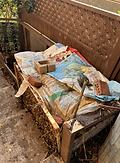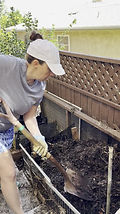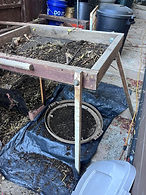Bin Compost
Compost is created by mixing browns. greens, air and water. There are endless ways to accomplish this. One classic way is with a three bin system. We built our bins out of wooden pallets and other scrap material. Turning the mix to add air is the most labor intensive part of the process but really great exercise!
Suggested Equipment
-
Chipper
-
Compost Thermometer
-
Sifter
Basic Materials
Here are some things to gather for your pile building:
Greens Browns
Kitchen Waste Yard waste such as chipped
Coffee Ground (small amount). branches and dead plants
Grass from clean source. Dried leaves
Chicken Manure
Bonus
Material
With some research around your local area, you might be able to find some more additives for your pile such as: rabbit, horse or goat droppings, waste material from beer making, etc. Anything you can find will add nutrients to your finished compost and subtract from the landfill!!
Don't Use
These !!!!
What to Avoid:
-
Meat, Fish, and Dairy Products: These can attract pests and create foul odors.
-
Diseased Plants: Avoid adding plants that are sick or have diseases.
-
Chemicall Treated Wood: Avoid adding wood that has been treated with chemicals.
-
Pet Waste: Do not add pet waste to your compost pile.
-
Charcoal Ash: Avoid adding charcoal ash to your compost pile.
-
Persistent Weeds: Avoid adding weeds that can regrow
Process
You are going to be adding layers of your collected materials, generally alternating between brown and green layers with browns being roughly 3-4 times thicker than the green layers. You might have some green/brown mix layers green/brown plants from the garden or bedding from a chicken coop) and more neutral layers like rabbit and goat poo. Keep adding layers and watering each one until the bin is overfill. Everything will break down quickly and the pile will shrink a lot.

The finer the bits of brown and green are the faster everything will decompose.
There are inexpensive chippers available that will break down all sorts of yard waste and speed up the process.
-
Start the pile with some large/medium branches to assist air flow from the bottom.
-
Add layers of green and brown materials with the brown layers thicker with the browns being 3 times as thick as the green.
-
The whole pile should be a minimum of 3' x 3'.

Cover the pile with plastic bags or a tarp to keep in the moisture. We also add bricks to discourage large critters from digging around and disturbing the pile.
Purchasing a compost thermometer is a great investment. Having compost that heats up has advantages: everything breaks down quickly, and weed seeds and diseases are killed off. Watch that the pile doesn't get too hot. Once it registers as cool, it is ready to be turned. Turning adds the air and most likely you will want to add water as well.

Continue this process and when the pile from the first bin has been turned twice it should be "finished". You can identify finished compost because it will be dark fine soil with nothing recognizable from the ingredients you began with.


Purchasing or making a sifter is another necessary bit of equipment. It's a simple process to make a wooden frame with hardware cloth that fits over a trash can. Reuse any large chunks in your new pile.


